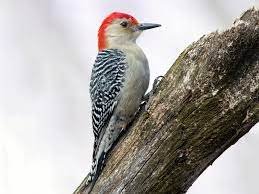The best method to observe Woodpeckers in Wisconsin is to go birding in the woods and forest, though you can often spot species like the Red-bellied, Hairy, and Downy Woodpeckers at your backyard feeders. Many species of birds, including the red-headed woodpecker, the northern flicker, and the yellow-bellied sapsucker, have their breeding grounds in Wisconsin. Wisconsin is home to two species of woodpeckers, the largest of which is the Pileated Woodpecker and the smallest of which is the Downy Woodpecker.
Red-bellied Woodpecker

Wisconsin is a year-round destination for red-bellied woodpeckers. Male Red-bellied Woodpeckers seem similar to male Red-headed Woodpeckers with their red hats and napes, but the former is much smaller. A red-bellied woodpecker’s diet consists primarily of insects, spiders, grass seeds, fruit, and nuts. Nestlings are another possible target. In some cases, they reuse the same nest from year to year since it is safe and secure in the dead tree. On a nest of wood chips, they deposit their four to five white eggs. When combined with its sticky spit, the Red-bellied Woodpecker’s tongue, which extends an additional 2 inches beyond the beak, is able to capture prey from the depths of cracks and crevices.
Also, know When Do Great Tits Nest?
Lewis’s Woodpecker

The green Lewis’s Woodpecker has a redhead that might appear black in certain lights and has a pinkish body. This bird looks like a woodpecker, but it soars like a crow and hunts insects like a flycatcher. Lewis’s woodpeckers are distinguished by their elongated bodies, long tails, and long wings, as well as their characteristic woodpecker beaks. They sit atop various structures including poles, cables, and bare branches in order to catch insects in flight.
You’ll most often spot them in areas of open ponderosa pine, woods, agricultural areas with scattered trees, orchards, and burned forests. Despite their rarity in the Badger State, winter is prime time to catch a glimpse of one.
Downy Woodpecker

In Wisconsin, you can hear Downy Woodpeckers all year round. They’re a little woodpecker species commonly spotted in green spaces like parks and backyards. Setting up a feeder in your yard is a terrific method to attract Downy Woodpeckers, which are more likely to visit feeders than other woodpecker species. These birds have been seen feeding on suet blocks and sunflower seeds, as well as using hummingbird feeders as watering holes.
Northern Flicker

There is a clear regional variation in how flickers look (Eastern vs Western). The tail feathers of Western flickers are tinged with yellow. Their body length is 12 inches, and their coloring ranges from tan to cream with a brown barred back. The males of the species possess a crimson mustache behind their bills and red napes.
To drill into the logs and trees they use, their beaks are bent, and their tongues are three inches longer than their bills. It’s fascinating to watch any kind of flicker bird forage for insects in vegetation or on grass.
Yellow-Bellied Sapsucker

Though it spends the winter in Wisconsin, the Yellow-Bellied Sapsucker can be spotted in the state all year (especially between April and November) despite breeding in Canada. These woodpeckers get their food by boring holes in trees, and their preferred food is the sap that flows out.
It’s easy to tell a male from a female since males have bright red foreheads and females have lighter ones. The species got its name because of the broad band of yellow that spans the animal’s trunk, abdomen, and breast. A male’s red throat patch is easily distinguishable from a female’s white one.
Pileated Woodpecker

The Pileated Woodpecker, the largest species of woodpecker, lives in Wisconsin throughout the year. The Pileated Woodpecker is instantly recognizable by its distinctive triangular crest of fiery scarlet. Almost the size of a crow, this woodpecker is among the largest in the world. The bottom of its wings is white, and its body is predominantly black with a white stripe. Males also get an extra red stripe on each cheek. Pileated woodpeckers eat a wide variety of foods, including carpenter ants, beetle larvae, termites, fruit and nuts like blackberries, sumac berries, dogwood, and elderberry, and various insects found in dead trees and logs. They have a raucous, strident, whinnying sound and a deep, pounding banging.
Black-backed Woodpeckers

The black-backed jackal does best in woods that have recently burned or seen significant death tolls. In order to get to the beetle larvae deep within the heart of dead or decaying trees, these woodpeckers will often spend a long period digging in the same area. This is one of Wisconsin’s rarest animals, as it can only be found in the northern half of the state. In reality, the BlackBacks’ amazing spread across the United States raises several unanswered questions about the nature of the biogeographic obstacles that may create such clear boundaries for the species.
American Three-Toed Woodpecker

Although this woodpecker is most commonly found in Canada, it occasionally travels to the northern states. It is a permanent resident of the western states of Idaho, Utah, Arizona, Colorado, and Wyoming. This bird prefers to dine in woodlands where fire or beetles have decimated the tree population. As part of its insect foraging, it pulls and strips away bark in search of tasty beetles.
The name of this bird gives away the fact that it only has three toes, but the unique patterning on its feathers will serve as a much more reliable way to spot it. The majority of it is black, but the sides, back, and chest are all white with black bars. This male sports a strikingly brilliant yellow headdress.





